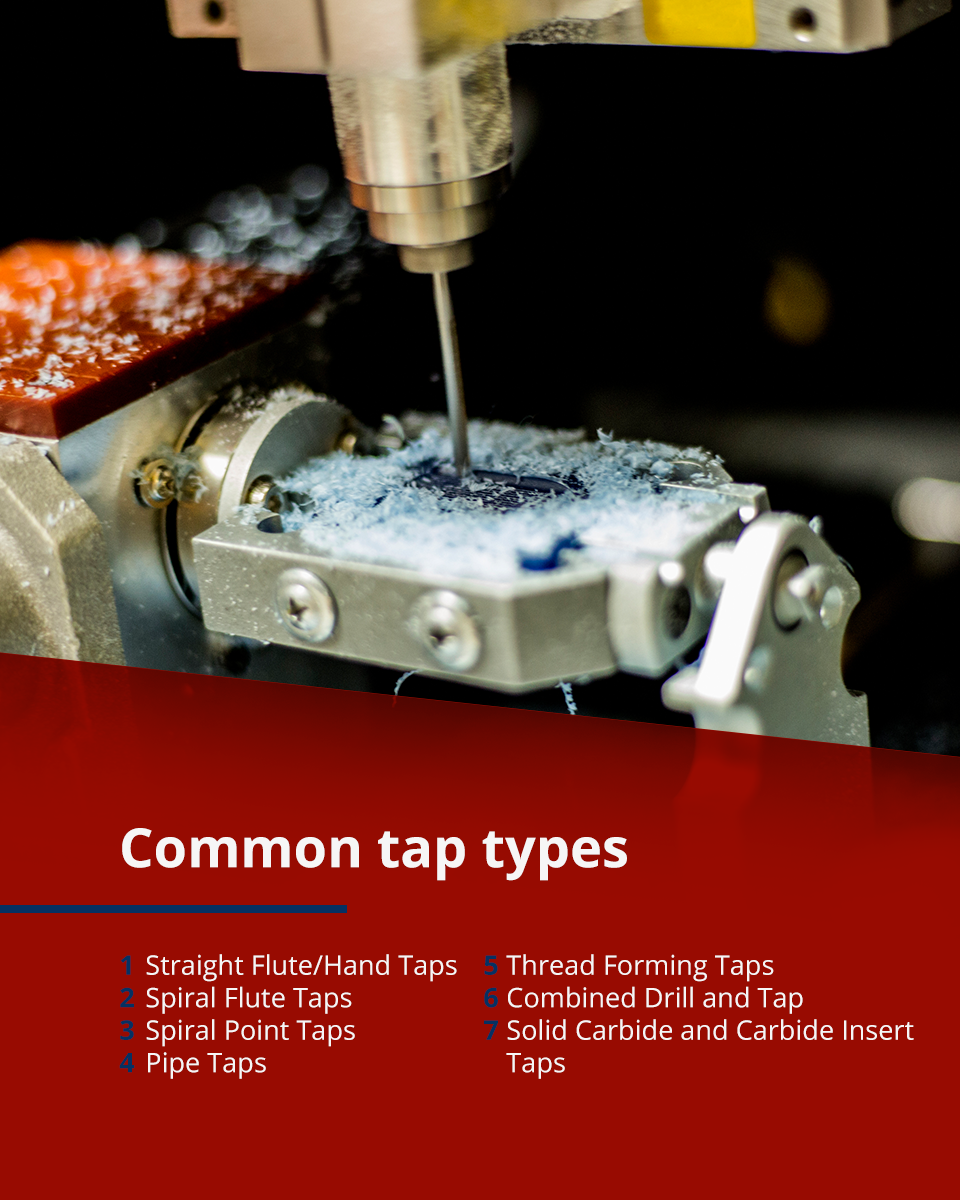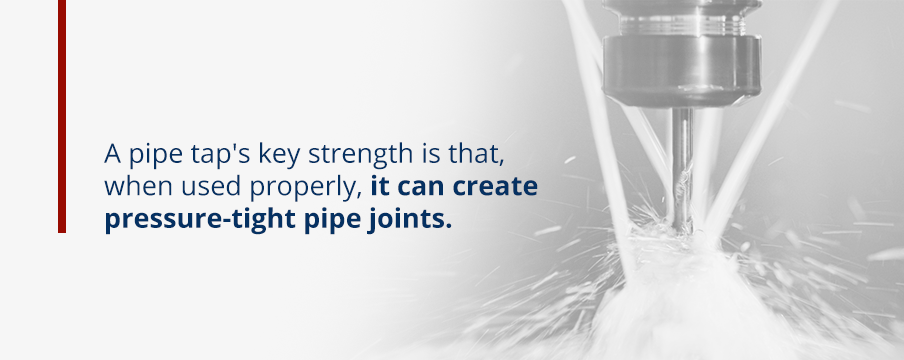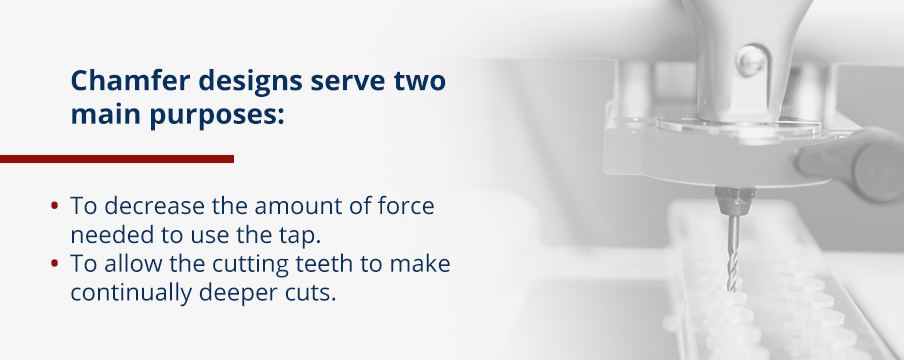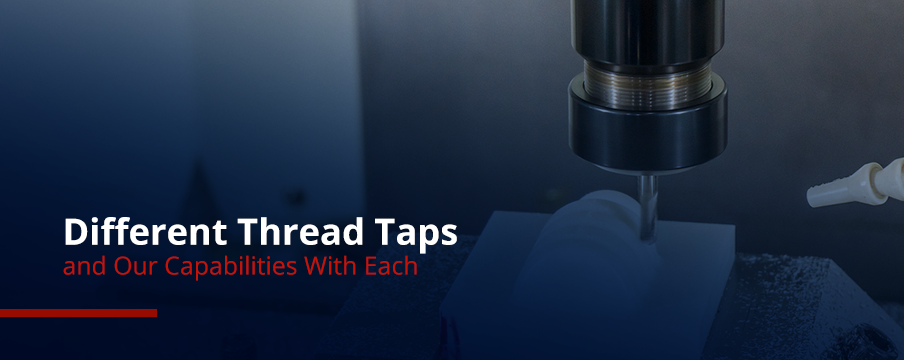Though engineers and machinists utilize thread taps for a wide range of applications, their purpose is fairly standard. Thread taps create the female portion of a pair of metal fasteners, which prepares a material to be used with a male component like bolts or screws. This concept is simple, but choosing a thread tap can be complex.
There are several different types of thread taps to accommodate your CNC machining needs. The right tap choice can help prevent frustrating tap breakage that may set you back on a component you’ve already poured hours into. Understanding each tap’s capabilities can help you narrow down what may work best in each situation. Let’s take a look at common thread taps you’ll want to consider.
Types of Thread Taps Used in CNC Machining
A thread tap’s construction can provide advantages depending on your project. Different taps may be appropriate depending on some of the following project specifications:
- Hole type: Your CNC tapping capabilities will depend on whether the hole you’re threading is a blind or through hole. Blind holes extend to a specific depth without breaking through the other side of a material, whereas through holes breach the other side. The shape of your thread tap will need to accommodate the hole type to prevent breakage.
- Fluting needs: Many thread taps have channels — known as flutes — cut into the body to guide chips away from the tapping site. Different flute types allow taps to either push chips ahead of the tool or draw them up and away from the tool. These fluting types can be valuable, depending on whether you’re tapping a blind or through hole.
- Material: The materials used in tapping will make a difference in the type of thread tap you choose. For example, a material’s hardness may warrant a stronger carbide tap rather than standard steel. The way the material forms chips is also important. When combined with certain taps, some materials form short chips, and others create spiraled chips. The direction your tap pushes a certain kind of chip can either work for or against your tapping process.
With these considerations in mind, let’s examine some common tap types, as well as their uses and benefits.

1. Straight Flute/Hand Taps
A straight flute or hand tap is one of the most basic taps available. This thread tap gets its name from the four straight channels that run along the body to handle chips. A straight flute or hand tap can be used with a machine or powered by hand, which gives it increased versatility. In addition, this tap type works well with through holes or blind holes.
Some of the strengths of a straight flute or hand tap include:
- Its one-size-fits-all nature may decrease the number of tools you need.
- It is well suited for materials like cast iron that create short chips.
- It can transition from a machine to a tap wrench depending on your needs.
2. Spiral Flute Taps
Spiral flute taps differ from straight flute taps due to their flute construction. As the name suggests, a spiral flute tap utilizes channels that spiral around the tap body in a helical form. This structure helps to guide chips upwards and away from the tap site, which is especially helpful when tapping a blind hole.
If you use a thread tap that pushes chips into the bottom of a blind hole, you could risk breaking or damaging the tap when you reach the bottom. Spiral flute taps mitigate this issue by evacuating the chips efficiently. You may want to differentiate your spiral flute tap further by choosing a spiral degree that aligns with the material you’re tapping:
- A 5-to-20-degree spiral: A low spiral degree generates slow spirals. This method does not impede the cutting edge, which is best for tough materials like titanium, nickel or stainless alloys.
- A 25-to-35-degree spiral: This configuration works well for free machining, leaded or low steels, as well as free-machining brass and bronze.
- A 38-to-42-degree spiral: This degree works well with materials that form relatively tight chips, such as free machining stainless steel or medium to high carbon steels.
- A 45-degree spiral or higher: Spiral taps with angles of 45 degrees or higher produce a fast spiral. This configuration works well for ductile materials like copper or aluminum.
In general, some of the strengths of a spiral flute tap include:
- It prevents chips from congregating at the bottom of a blind hole.
- It may take less effort to tap.
- It makes it easier to restart tapping when working with a hole that’s interrupted by another feature.
3. Spiral Point Taps
A spiral point tap utilizes a small but important variation on the straight flute tap. Spiral point taps have an angled point that helps direct chips out in front of the tool during tapping. Given this construction, spiral point tap capabilities encompass both through holes and blind holes with enough room to accommodate chips.
Many of the spiral point tap’s strengths stem from its shallow flute design, including:
- Increased cross-sectional areas
- Greater tapping strength with less tapping power required
- Capacity for increased tapping speeds
4. Pipe Taps
A pipe tap has a more narrow application centered around creating pipe threads. This tool is used to cut the threads in a portion of a pipe fitting or part that will be paired with the portion of an adjoining pipe. Because of this use, pipe taps tend to have several straight flutes and require more force to use.
You may use a type of pipe tap that differs from standard construction based on your project:
- Spiral flute pipe taps: A spiral flute pipe tap combines the helical channels of a spiral flute tap with the standard pipe tap structure. This tool draws chips away from the tapping hole when they may cause issues otherwise.
- Interrupted thread pipe taps: This type of pipe tap has a tooth removed on each cutting edge to increase chip flow and cut down on tapping friction. Interrupted pipe taps tend to have an odd number of threads and may be used on a variety of metals.
- Extension pipe taps: Extension pipe taps are designed to drill deep holes in pipes or pipe fittings. An extension pipe tap may incorporate either a standard or interrupted thread pattern that helps when tapping difficult areas.
- Thread forming pipe taps: A thread forming pipe tap displaces material rather than cutting it. This type of tap may be a good choice when working with pipes made of soft metal, steel, copper, aluminum or brass.

A pipe tap’s key strength is that, when used properly, it can create pressure-tight pipe joints.
5. Thread Forming Taps
Thread forming taps stand out from other tap types because they produce threads differently. Most taps utilize cutting edges to shave away material and create a thread. While this is effective, it makes inconvenient chips that can impede the tapping process. Instead of cutting, a thread forming tap displaces material during tapping.
The thread forming method offers a variety of advantages, including:
- Strength: Formed threads are stronger than cut threads.
- Convenience: Thread forming taps do not produce chips, which is helpful for blind holes.
- Longevity: Thread forming taps may be less likely to break or wear down.
- Efficiency: Thread forming taps may run at faster speeds than cutting taps.
Because of their unique functionality, thread forming taps are best suited for somewhat malleable materials, such as:
- Aluminum
- Soft steels
- Brass
- Lead
- Copper
- Zinc
- Other medium alloys
An important consideration for thread forming taps is lubrication. The thread forming method generates increased friction, which can hinder a successful thread. For this reason, most thread forming taps include grooves or channels that help transport lubricant to the front of the tap. A dedicated tapping or extrusion fluid may support the best results when using this type of tool.
6. Combined Drill and Tap
As its name suggests, a combined drill and tap can bore and thread a hole in one pass. A combined drill and tap typically features a drill bit at the tip followed by a spiral fluted tap. This tool is designed so the drill portion of the tap breaks through the material before the threading section begins.
A combined drill and tap is recommended for through holes only and can handle depths of up to twice the tap’s diameter. This tool may have a variety of applications within the assembly, construction, maintenance and repair industries.
Some of the strengths of a combined drill and tap include:
- It is self-centering.
- It operates at high speeds.
- It can save time where applicable.
7. Solid Carbide and Carbide Insert Taps
Most thread taps are made from steel, but some use carbide because of the advantages it provides. As a material, carbide is extra strong and extra efficient. This makes it ideal when tapping more abrasive substances such as:
- Cast iron
- Cast aluminum
- Polymers
- Glass-filled polycarbonates
- Other non-ferrous materials
Carbide taps may come in one of two configurations:
- Solid carbide taps: These taps are completely fashioned from carbide material, which allows for increased metal removal at high speeds.
- Carbide insert taps: These taps incorporate carbide at the cutting portion of the tool and High Speed Steel (HSS) in the body. Though not as strong as a solid carbide tap, a carbide insert tap can be more affordable.
Solid carbide and carbide insert taps are manufactured in many of the tap configurations we’ve covered. If you need extra strength and durability for your project, you can choose one of the following:
- Carbide straight flute taps
- Carbide spiral point taps
- Carbide pipe taps
- Carbide thread forming taps
Types of Chamfers Used in CNC Machining

A thread tap can be further differentiated by the type of chamfer it has. The term chamfer refers to the bottom-most section of a tap. Chamfer designs serve two main purposes: to decrease the amount of force needed to use the tap and to allow the cutting teeth to make continually deeper cuts.
Manufacturers use varying chamfer angles and lengths depending on a thread tap’s purpose. When choosing a chamfer type, your primary consideration should be the type of hole you’re tapping and its depth. There are three main chamfer types you may encounter in CNC machining.
1. Taper Taps
A tapered tap has the longest chamfer length — usually about seven to 10 threads long. In general, the longer a tap’s chamfer, the easier it will be to begin tapping a hole. A tapered chamfer has a slight inward angle, which makes it easier to align the tap within your hole.
Because tapered taps don’t have fully formed threads in the chamfer, they are not ideal to use when tapping the bottom of a blind hole. Instead, tapered taps work well for through holes or when cutting threads for the first time. You can typically pair a tapered tap with another chamfer style to get the results you need.
2. Plug Taps
Plug taps have medium-sized chamfers between three and five threads long with a medium inward angle. A plug tap’s shallow construction requires more force to start a new thread, which makes it more difficult to use than a taper tap.
This chamfer style works well when you’re repairing a thread that has already been tapped. It can also help tap deeper into a hole once you’ve started the hole with a taper tap. If you’re threading a through hole, a plug tap can be a more effective choice than a taper tap due to its construction.
3. Bottoming Taps
A bottoming tap has the smallest chamfer with just one or two threads. This chamfer type has a sharp inward angle, which makes it ideal for cutting threads to the bottom of a blind hole. Because a bottoming chamfer is so short, it’s extremely difficult to use when beginning a new thread. Bottoming taps are ideal to use after you’ve tapped a hole with a taper or plug tap.
Enhance Your CNC Machining With Custom Thread Taps From American Micro Industries

No matter what kind of CNC machining projects you encounter, the right tools can improve your precision and outcomes. If you’re looking for ways to enhance performance, upgrading your thread taps could be a helpful step. At American Micro Industries, we understand some projects require more than mass-produced tools or parts. We’re here to provide high-quality, custom solutions that fit your needs perfectly.
When you work with us, you’ll benefit from our ability to streamline the custom manufacturing process under one roof. We’ll cover everything from research to material identification to prototyping and more. Our immense attention to detail drives us to do everything possible to ensure you’re completely satisfied with your custom-made product.
If you need a prototype machined or want to learn more about improving your CNC machining projects, contact us or request a quote online today.



